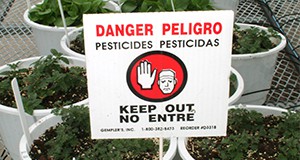
Precautionary statements found on pesticide labeling tell the user information about the toxicity, irritation, and sensitization hazards associated with the use of the pesticide. These labels also provide treatment instructions and information to reduce exposure potential. This five-page fact sheet describes the different types of statements found on pesticide labels, as well as the instructions for personal protective equipment, and first-aid treatments. This publication also contains several reference tables for pesticide labels and their meanings. Written by Frederick M. Fishel, and published by the Agronomy Department.
http://edis.ifas.ufl.edu/pi259
Category: Agriculture
Pesticide Emergencies: Contingency Planning
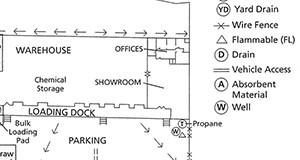
In the event of a pesticide emergency, having a an emergency response plan can help protect the health and welfare of employees and the community, minimize environmental damage, and potentially reduce liability. The goal of contingency planning is to prevent emergencies; but if an emergency does occur, the contingency plan allows business owners and managers to react appropriately in order to minimize detrimental effects.This eleven-page fact sheet provides insight on how to develop a contingency plan for addressing emergencies where pesticides are involved. Written by Frederick M. Fishel, and published by the Agronomy Department.
http://edis.ifas.ufl.edu/pi257
The Cost of Food Safety
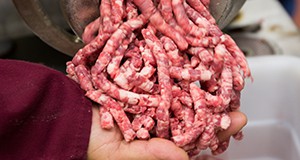 This new publication discusses the costs and long-term benefits associated with the implementation of food safety programs. This 5-page fact sheet covers the history of HACCP, costs associated with the application of food safety programs, reasons to improve food safety, and the financial impact of foodborne illnesses. Written by Annelys Hessing, Renée Goodrich Schneider, Alan Gutierrez, Rachael Silverberg, Michael S. Gutter, and Keith R. Schneider, and published by the UF Department of Food Science and Human Nutrition, October 2015.
This new publication discusses the costs and long-term benefits associated with the implementation of food safety programs. This 5-page fact sheet covers the history of HACCP, costs associated with the application of food safety programs, reasons to improve food safety, and the financial impact of foodborne illnesses. Written by Annelys Hessing, Renée Goodrich Schneider, Alan Gutierrez, Rachael Silverberg, Michael S. Gutter, and Keith R. Schneider, and published by the UF Department of Food Science and Human Nutrition, October 2015.
http://edis.ifas.ufl.edu/fs270
Sizzle and Passionista: Two New Lance-Leaved Caladium Cultivars
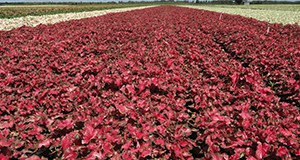 Many lance-leaved cultivars often produce small tubers, making it difficult for growers to produce tubers profitably. ‘Sizzle’ and ‘Passionista’ are two new lance-leaved caladium cultivars with improved tuber yield potential. The availability of ‘Sizzle’ and ‘Passionista’ may expand the color palette for caladium plants desired by greenhouse growers, nurseries, and gardeners. This 7-page fact sheet discusses the cultivars' tuber yield potential, container trials, landscape performance, growing recommendations, and availability. Written by Zhanao Deng, and published by the UF Department of Environmental Horticulture, December 2015.
Many lance-leaved cultivars often produce small tubers, making it difficult for growers to produce tubers profitably. ‘Sizzle’ and ‘Passionista’ are two new lance-leaved caladium cultivars with improved tuber yield potential. The availability of ‘Sizzle’ and ‘Passionista’ may expand the color palette for caladium plants desired by greenhouse growers, nurseries, and gardeners. This 7-page fact sheet discusses the cultivars' tuber yield potential, container trials, landscape performance, growing recommendations, and availability. Written by Zhanao Deng, and published by the UF Department of Environmental Horticulture, December 2015.
http://edis.ifas.ufl.edu/ep527
A Summary of Revisions to the Worker Protection Standard: 2015
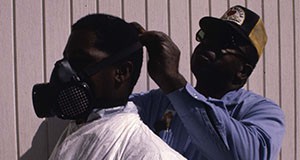
In 1992, the US Environmental Protection Agency (EPA) issued a comprehensive regulation called the Worker Protection Standard for Agricultural Pesticides (WPS). The WPS covers pesticides used in the outdoor and enclosed space production of plants on farms, forests, and nurseries, as well as greenhouses. The EPA has made several changes to the WPS since it was fully implemented in 1995. On November 2, 2015, the EPA revised the WPS, making significant changes to the rule’s requirements. This five-page fact sheet explains those changes. Written by Frederick M. Fishel, and published by the Agronomy Department.
http://edis.ifas.ufl.edu/pi261
Implementing the Four Rs (4Rs) in Nutrient Stewardship for Tomato Production
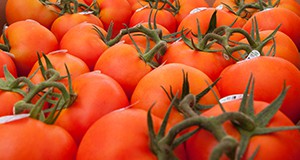 Fertilization plays a critical role in tomato production across the state of Florida. However, appropriate fertilization management depends on four major components (4Rs): right source, right rate, right placement, and right timing. Farming practices that follow the 4Rs can provide nutrients for optimal tomato productivity while minimizing the risk of nutrient losses and adverse environmental effects, both of which are important to the development of agricultural sustainability. This 6-page fact sheet discusses the 4Rs as well as conventional dry source fertilizers, controlled-release or slow-release source fertilizers, and liquid source fertilizers. Written by Qingren Wang, Guodong Liu, Kelly Morgan, and Yuncong Li, and published by the UF Department of Horticultural Sciences, October 2015.
Fertilization plays a critical role in tomato production across the state of Florida. However, appropriate fertilization management depends on four major components (4Rs): right source, right rate, right placement, and right timing. Farming practices that follow the 4Rs can provide nutrients for optimal tomato productivity while minimizing the risk of nutrient losses and adverse environmental effects, both of which are important to the development of agricultural sustainability. This 6-page fact sheet discusses the 4Rs as well as conventional dry source fertilizers, controlled-release or slow-release source fertilizers, and liquid source fertilizers. Written by Qingren Wang, Guodong Liu, Kelly Morgan, and Yuncong Li, and published by the UF Department of Horticultural Sciences, October 2015.
http://edis.ifas.ufl.edu/hs1269
Bitter Melon: An Asian Vegetable Emerging in Florida
 Bitter melon is a tropical and subtropical vegetable crop with long climbing vines which is widely cultivated in Asia, Africa, and the Caribbean. The unripe fruit is used as a vegetable with a pleasantly bitter taste. This 7-page fact sheet provides an overview of this plant as well as recommendations for individuals in Florida who are interested in growing it. Written by Guodong Liu, Qingren Wang, Yuncong Li, David Dinkins, Bonnie Wells, and Yuqi Cui, and published by the UF Department of Horticultural Sciences, December 2015.
Bitter melon is a tropical and subtropical vegetable crop with long climbing vines which is widely cultivated in Asia, Africa, and the Caribbean. The unripe fruit is used as a vegetable with a pleasantly bitter taste. This 7-page fact sheet provides an overview of this plant as well as recommendations for individuals in Florida who are interested in growing it. Written by Guodong Liu, Qingren Wang, Yuncong Li, David Dinkins, Bonnie Wells, and Yuqi Cui, and published by the UF Department of Horticultural Sciences, December 2015.
http://edis.ifas.ufl.edu/hs1271
First Aid for Pesticide Exposure

Pesticide poisoning is a commonly under-diagnosed illness. This five-page fact sheet describes how to recognize the early symptoms of pesticide exposure and provide basic first aid for the treatment of victims. This fact sheet explains how to provide initial treatment in the case of pesticide exposure on the skin, in the eye, through inhalation, and in the mouth or swallowed. Written by Frederick M. Fishel, and published by the Agronomy Department.
http://edis.ifas.ufl.edu/pi256
Cost of Production for Processed Oranges in Southwest Florida, 2014/15
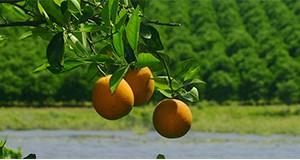
UF/IFAS researchers collected data from twelve growers to estimate the cost of production per acre for processed oranges in southwest Florida during 2014/15. The cost estimates in this 4-page fact sheet written by Ariel Singerman and published by the Food and Resource Economics Department do not represent any individual operation. Instead, their purpose is to serve as a benchmark for the Florida citrus industry. Typical users of these estimates include growers, consultants, property appraisers, and researchers.
http://edis.ifas.ufl.edu/fe986
Tomato Cultivar Selection Considerations for Open-Field and Protected Culture in North Florida
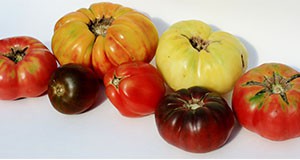
Tomatoes represent one of the most popular vegetables grown in protected culture such as greenhouses, high tunnels, or shade houses. Selecting the correct cultivar of tomato is critical and varies depending on the intended season, type of protected structure, training system, expected insect and disease pressure, post-harvest handling techniques, and intended market. This seven-page fact sheet will focus on the key factors affecting the cultivar selection decisions for growing and selling tomatoes in north Florida. Written by Blake R. Thaxton and Robert C. Hochmuth, and published by the Horticultural Sciences Department.
http://edis.ifas.ufl.edu/hs1273
Long Squash: An Asian Vegetable Emerging in Florida
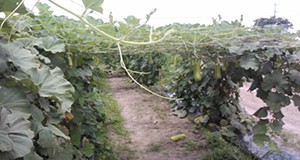 Long squash is an annual, vigorous, and herbaceous crop that was brought to the Americas by Paleoindian populations from Asia before the arrival of Columbus. This 4-page fact sheet provides an overview of this plant as well as recommendations for individuals in Florida who are interested in growing it. Written by Guodong Liu, Yuncong Li, David Dinkins, Bonnie Wells, Qingren Wang, and Yuqi Cui, and published by the UF Department of Horticultural Sciences, December 2015.
Long squash is an annual, vigorous, and herbaceous crop that was brought to the Americas by Paleoindian populations from Asia before the arrival of Columbus. This 4-page fact sheet provides an overview of this plant as well as recommendations for individuals in Florida who are interested in growing it. Written by Guodong Liu, Yuncong Li, David Dinkins, Bonnie Wells, Qingren Wang, and Yuqi Cui, and published by the UF Department of Horticultural Sciences, December 2015.
http://edis.ifas.ufl.edu/hs1272
The Economic Impact of Feed Efficiency in Beef Cattle
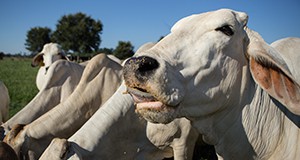 A well-run, profitable business is usually more efficient than its competitors. In the case of the beef cattle industry, competition can come from two sources: other producers who sell similar classes of cattle, and other protein-producing species, such as pork and poultry. Measuring efficiency across the entire integrated beef system can be difficult due to the differing classes of cattle, breed differences, and ways in which the biological systems interact. There are a multitude of measures of efficiency in beef production, with feed efficiency being one of the most economic. This 3-page fact sheet is a major revision that covers feed to gain ratio and residual feed intake in beef cattle. Written by Travis D. Maddock, Darren D. Henry, and G. Cliff Lamb, and published by the UF Department of Animal Sciences. Original publication date: May 2009. Revised October 2015.
A well-run, profitable business is usually more efficient than its competitors. In the case of the beef cattle industry, competition can come from two sources: other producers who sell similar classes of cattle, and other protein-producing species, such as pork and poultry. Measuring efficiency across the entire integrated beef system can be difficult due to the differing classes of cattle, breed differences, and ways in which the biological systems interact. There are a multitude of measures of efficiency in beef production, with feed efficiency being one of the most economic. This 3-page fact sheet is a major revision that covers feed to gain ratio and residual feed intake in beef cattle. Written by Travis D. Maddock, Darren D. Henry, and G. Cliff Lamb, and published by the UF Department of Animal Sciences. Original publication date: May 2009. Revised October 2015.
http://edis.ifas.ufl.edu/an217
What Else Can Surface Water Buffer Systems Do?: Exploring Multiple Ecosystem Services
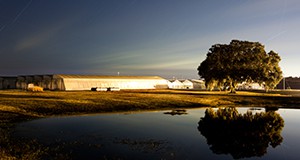 As society confronts the consequences of global warming, deteriorating water quality, and impoverished biodiversity, there is a growing urgency to develop and expand water buffers' multifunctional ecosystem services. However, limited information is available on other potential co-benefits associated with the use of buffers, particularly VFSs. This 5-page fact sheet provides information on buffers' multiple ecosystem benefits, such as niche products production, carbon sequestration, and flood risk mitigation, as well as recommendations on future research needs necessary to enhance multiple ecosystem services and benefits of buffers. Written by Lei Wu, Rafael Muñoz-Carpena, and Yuncong Li, and published by the UF Department of Soil and Water Science, November 2015.
As society confronts the consequences of global warming, deteriorating water quality, and impoverished biodiversity, there is a growing urgency to develop and expand water buffers' multifunctional ecosystem services. However, limited information is available on other potential co-benefits associated with the use of buffers, particularly VFSs. This 5-page fact sheet provides information on buffers' multiple ecosystem benefits, such as niche products production, carbon sequestration, and flood risk mitigation, as well as recommendations on future research needs necessary to enhance multiple ecosystem services and benefits of buffers. Written by Lei Wu, Rafael Muñoz-Carpena, and Yuncong Li, and published by the UF Department of Soil and Water Science, November 2015.
http://edis.ifas.ufl.edu/ss647
Vegetative Filter Strips: A Best Management Practice for Controlling Nonpoint Source Pollution
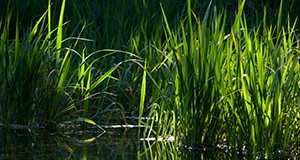 Increasing numbers of pollutants have been observed in natural water systems. As awareness of agricultural sources of water pollution has grown, Best Management Practices (BMPs) have been specifically designed to address agricultural water pollutants and protect water quality. This 4-page fact sheet introduces one of the BMPs, Vegetative Filter Strips (VFSs), which efficiently control nonpoint pollution such as sediments, nutrients, and pesticides. The publication covers primary functions, key design factors, and maintenance of VFSs. Written by Lei Wu, Rafael Muñoz-Carpena, and Yuncong Li, and published by the UF Department of Soil and Water Science, October 2015.
Increasing numbers of pollutants have been observed in natural water systems. As awareness of agricultural sources of water pollution has grown, Best Management Practices (BMPs) have been specifically designed to address agricultural water pollutants and protect water quality. This 4-page fact sheet introduces one of the BMPs, Vegetative Filter Strips (VFSs), which efficiently control nonpoint pollution such as sediments, nutrients, and pesticides. The publication covers primary functions, key design factors, and maintenance of VFSs. Written by Lei Wu, Rafael Muñoz-Carpena, and Yuncong Li, and published by the UF Department of Soil and Water Science, October 2015.
http://edis.ifas.ufl.edu/ss646
Risk Management for 4-H Youth Development Work: Large Animals: Livestock
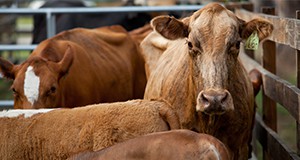 Most people involved in youth livestock exhibition are familiar with the physical risks of handling and transporting livestock, but public spectators generally need more instruction and supervision to ensure their safety and health. The Risk Management for 4-H Youth Development Work series aims to provide UF/IFAS Extension county faculty, staff, volunteers, and youth with the knowledge they need to implement best practices in risk management strategies. This 8-page fact sheet covers risks in the following categories: injuries to people, injuries to animals, property damage, biosecurity (diseases transmitted to humans and between animals), and general precautions. Written by Chad Carr, Saundra TenBroeck, Wendy DeVito, Chris Strong, Dale Pracht, and Georgene Bender, and published by the UF Department of Animal Sciences, November 2015.
Most people involved in youth livestock exhibition are familiar with the physical risks of handling and transporting livestock, but public spectators generally need more instruction and supervision to ensure their safety and health. The Risk Management for 4-H Youth Development Work series aims to provide UF/IFAS Extension county faculty, staff, volunteers, and youth with the knowledge they need to implement best practices in risk management strategies. This 8-page fact sheet covers risks in the following categories: injuries to people, injuries to animals, property damage, biosecurity (diseases transmitted to humans and between animals), and general precautions. Written by Chad Carr, Saundra TenBroeck, Wendy DeVito, Chris Strong, Dale Pracht, and Georgene Bender, and published by the UF Department of Animal Sciences, November 2015.
http://edis.ifas.ufl.edu/an321
Long Bean: An Asian Vegetable Emerging in Florida
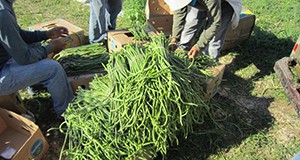 Food diversity, nutritional food supply, and profitability are the priorities of agricultural and horticultural industries. To diversify vegetable products and increase the Florida vegetable industry's competitiveness, a number of new vegetable crops are rapidly emerging in the state. Due to Florida's favorable climate, these vegetable crops grow well and have high market potential. The objective of this 6-page fact sheet is to provide a general overview of long bean, one of the Asian vegetable crops grown in Florida. Written by Kshitij Khatri, Guodong Liu, Qingren Wang, Yuncong Li, David Dinkins, and Bonnie Wells, and published by the UF Department of Horticultural Sciences, October 2015.
Food diversity, nutritional food supply, and profitability are the priorities of agricultural and horticultural industries. To diversify vegetable products and increase the Florida vegetable industry's competitiveness, a number of new vegetable crops are rapidly emerging in the state. Due to Florida's favorable climate, these vegetable crops grow well and have high market potential. The objective of this 6-page fact sheet is to provide a general overview of long bean, one of the Asian vegetable crops grown in Florida. Written by Kshitij Khatri, Guodong Liu, Qingren Wang, Yuncong Li, David Dinkins, and Bonnie Wells, and published by the UF Department of Horticultural Sciences, October 2015.
http://edis.ifas.ufl.edu/hs1268
Pest Identification Guide: An Introduction to Thrips
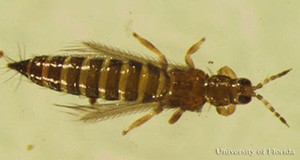 Tiny insects called thrips are difficult to see with the unaided eye but cause very obvious and sometimes ruinous damage to the flowers, buds, and fruit of many important crops. This two-page guide asks and answers the key thrips questions that allow growers to distinguish between chilli thrips, common blossom thrips, and Western flower thrips to more effectively battle against these destructive pests. What does it look like? What is its life cycle? Where is it found? What type of damage does it cause? And, most importantly, who are its natural enemies? Use this guide to help you identify thrips so that you can take effective steps to control them and limit the damage they cause. Written by Nicole Casuso and Hugh Smith with photos by Lyle Buss, Jeff Cluever, Vivek Kumar, P.M.J. Ramakers, Gary Vallad, and Hugh Smith. Published by the Entomology and Nematology Department, UF/IFAS Extension.
Tiny insects called thrips are difficult to see with the unaided eye but cause very obvious and sometimes ruinous damage to the flowers, buds, and fruit of many important crops. This two-page guide asks and answers the key thrips questions that allow growers to distinguish between chilli thrips, common blossom thrips, and Western flower thrips to more effectively battle against these destructive pests. What does it look like? What is its life cycle? Where is it found? What type of damage does it cause? And, most importantly, who are its natural enemies? Use this guide to help you identify thrips so that you can take effective steps to control them and limit the damage they cause. Written by Nicole Casuso and Hugh Smith with photos by Lyle Buss, Jeff Cluever, Vivek Kumar, P.M.J. Ramakers, Gary Vallad, and Hugh Smith. Published by the Entomology and Nematology Department, UF/IFAS Extension.
http://edis.ifas.ufl.edu/in1058
US Consumer Preferences for Home Lawn Fertilizers
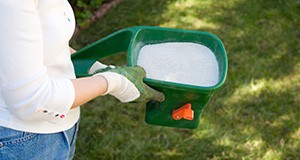
Consumer preferences for home lawn fertilizers are not always informed and do not always align with best practices. Understanding the disconnect will help turf industry educators better address consumers’ misperceptions about fertilizers, and help industry stakeholders design more appealing products and educate consumers effectively as they promote them. Knowing consumer preferences greatly reduces stakeholders’ risks and improves efficiency in determining future product and promotional strategies. This 4-page report discusses the findings of a 2013 survey of 1,066 US homeowners about their preferences and willingness-to-pay for various lawn fertilizer attributes. Written by Hayk Khachatryan, Alicia Rihn, and Michael Dukes and published by the Food and Resource Economics Department.
edis.ifas.ufl.edu/fe975
Florida Consumer Perception of the Fresh from Florida Campaign on Horticulture Plants

Consumer demand for local products is increasing all the time because of perceptions of superior quality and the idea that local products benefit personal health, the local community, and the environment. Many states have publicly funded marketing programs to promote the consumption of local products. In a new development in Florida, the Department of Agriculture and Consumer Services (FDACS) has partnered with the Florida Nursery, Growers, and Landscape Association to include horticulture plants in the state’s Fresh from Florida campaign for the first time. This 3-page report written by Hayk Khachatryan and Alicia Rihn and published by the Food and Resource Economics Department provides an overview of Florida consumer perceptions of the new Fresh from Florida campaign for horticultural plants. Growers, wholesalers, marketers, and retailers can use the tips inside to understand consumer perceptions and discover how best to use the promotional materials of the new program to reach consumers, reduce economic risks and improve their returns on investment.
http://edis.ifas.ufl.edu/fe976
Carp Edema Virus Disease (CEVD) / Koi Sleepy Disease (KSD)
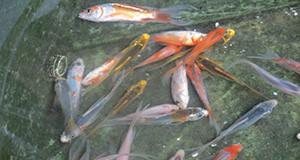
Carp edema virus disease is killing wild and cultured varieties of carp and worrying koi enthusiasts and carp aquaculturists in the United States and around the world. The disease causes skin lesions and swelling and is sometimes called “koi sleepy disease” because infected fish become lethargic and unresponsive. This 5-page fact sheet describes symptoms, diagnosis, prevention, and what fish producers, wholesalers, or retailers can do if they suspect carp may have contracted the disease. Written by Shohreh Hesami, Pedro Viadanna, Natalie Steckler. Staci Spears, Patrick Thompson, Karen Kelley, Roy Yanong, Ruth Francis-Floyd, Johnny Shelley, Joseph Groff, Andy Goodwin, Olga Haenen, and Thomas Waltzek, and published by the School of Forest Resources and Conservation Program in Fisheries and Aquatic Sciences.
http://edis.ifas.ufl.edu/fa189